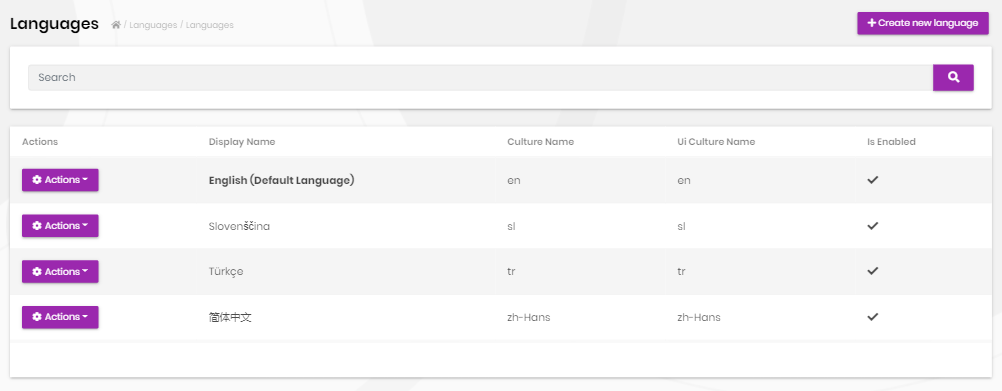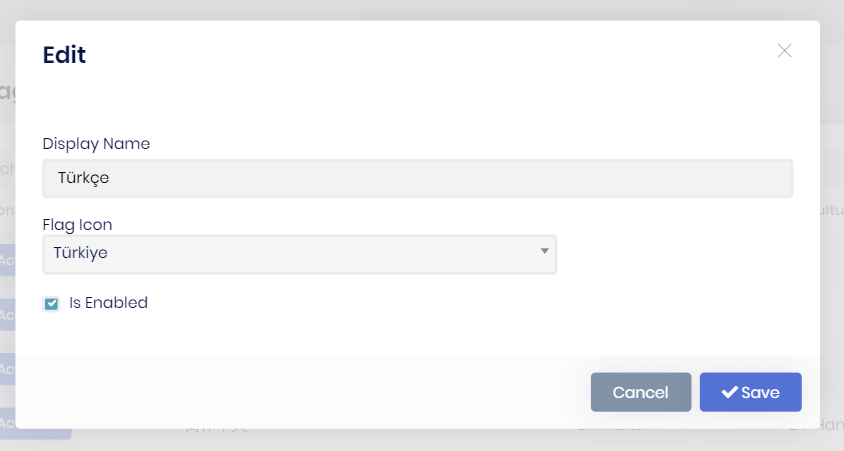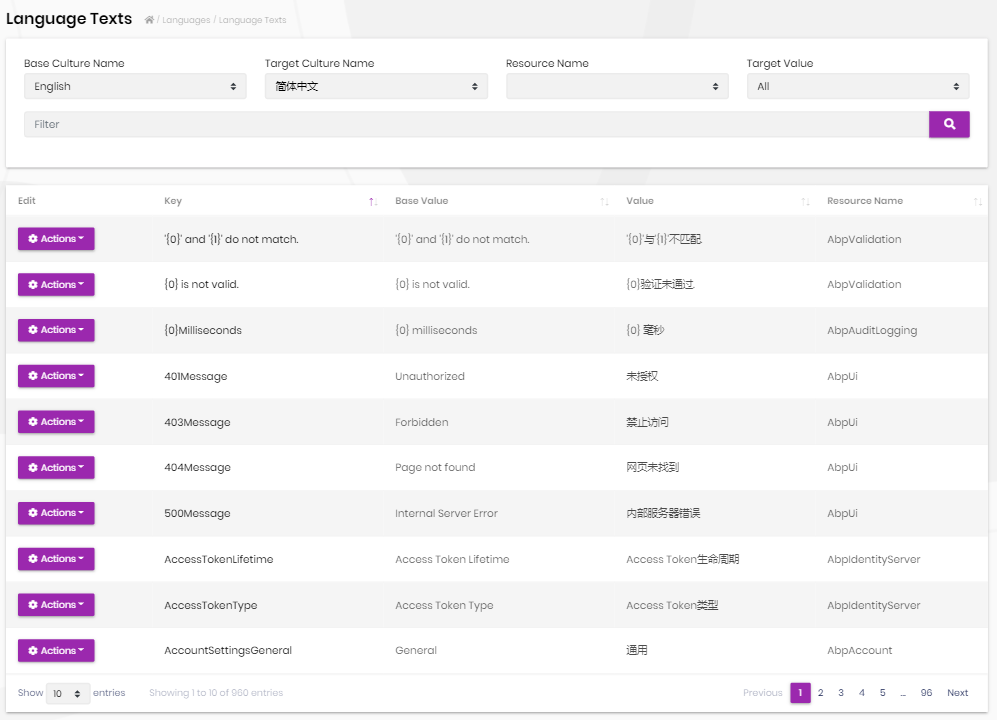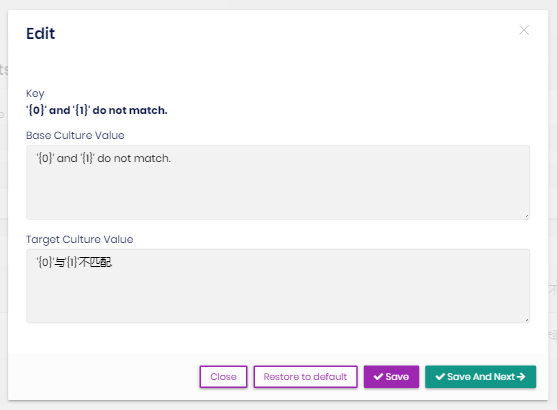Language Management Module
This module implements the Language management system of an application;
- Manage languages in the system.
- Translate texts in the UI.
- Enable/disable languages.
- Select default language in the UI.
See the module description page for an overview of the module features.
How to Install
Language management module is pre-installed in the startup templates. So, no need to manually install it.
Packages
This module follows the module development best practices guide and consists of several NuGet and NPM packages. See the guide if you want to understand the packages and relations between them.
You can visit Language Management module package list page to see list of packages related with this module.
User Interface
Menu Items
Language management module adds the following items to the "Main" menu, under the "Administration" menu item:
- Languages: Language management page.
- Language Texts: Language text management page.
LanguageManagementMenuNames class has the constants for the menu item names.
Pages
Languages
Languages page is used to manage languages in the system.
You can create a new language or edit an existing language in this page:
- Enabled languages can be selected as the system language.
Language Texts
Language texts page is used to manage texts in different languages.
You can translate a text for a language or edit the already existing translation in this page.
Data Seed
This module adds some initial data (see the data seed system) to the database when you run the .DbMigrator application:
- Creates language records configured using
AbpLocalizationOptions.
If you want to change the seeded language list, see the next section.
Internals
Domain Layer
Aggregates
This module follows the Entity Best Practices & Conventions guide.
Language
Language(aggregate root): Represents a language in the system.LanguageText(aggregate root): Represents a language text in the system.
Repositories
This module follows the Repository Best Practices & Conventions guide.
Following custom repositories are defined for this module:
ILanguageRepositoryILanguageTextRepository
Domain Services
This module doesn't define any domain service.
Settings
This module doesn't define any setting.
Application Layer
Application Services
LanguageAppService(implementsILanguageAppService): Implements the use cases of the language management UI.LanguageTextAppService(implementsILanguageTextAppService): Implements the use cases of the language texts management UI.
Database Providers
Common
Table/Collection Prefix & Schema
All tables/collections use the Abp prefix by default. Set static properties on the LanguageManagementDbProperties class if you need to change the table prefix or set a schema name (if supported by your database provider).
Connection String
This module uses AbpLanguageManagement for the connection string name. If you don't define a connection string with this name, it fallbacks to the Default connection string.
See the connection strings documentation for details.
Entity Framework Core
Tables
- AbpLanguages
- AbpLanguageTexts
MongoDB
Collections
- AbpLanguages
- AbpLanguageTexts
Permissions
See the LanguageManagementPermissions class members for all permissions defined for this module.
Angular UI
Installation
In order to configure the application to use the LanguageManagementModule, you first need to import LanguageManagementConfigModule from @volo/abp.ng.language-management/config to root module. LanguageManagementConfigModule has a static forRoot method which you should call for a proper configuration.
// app.module.ts
import { LanguageManagementConfigModule } from '@volo/abp.ng.language-management/config';
@NgModule({
imports: [
// other imports
LanguageManagementConfigModule.forRoot(),
// other imports
],
// ...
})
export class AppModule {}
The LanguageManagementModule should be imported and lazy-loaded in your routing module. It has a static forLazy method for configuration. Available options are listed below. It is available for import from @volo/abp.ng.language-management.
// app-routing.module.ts
const routes: Routes = [
// other route definitions
{
path: 'language-management',
loadChildren: () =>
import('@volo/abp.ng.language-management').then(m => m.LanguageManagementModule.forLazy(/* options here */)),
},
];
@NgModule(/* AppRoutingModule metadata */)
export class AppRoutingModule {}
If you have generated your project via the startup template, you do not have to do anything, because it already has both
LanguageManagementConfigModuleandLanguageManagementModule.
Options
You can modify the look and behavior of the module pages by passing the following options to LanguageManagementModule.forLazy static method:
- entityActionContributors: Changes grid actions. Please check Entity Action Extensions for Angular for details.
- toolbarActionContributors: Changes page toolbar. Please check Page Toolbar Extensions for Angular for details.
- entityPropContributors: Changes table columns. Please check Data Table Column Extensions for Angular for details.
- createFormPropContributors: Changes create form fields. Please check Dynamic Form Extensions for Angular for details.
- editFormPropContributors: Changes create form fields. Please check Dynamic Form Extensions for Angular for details.
Services / Models
Language Management module services and models are generated via generate-proxy command of the ABP CLI. If you need the module's proxies, you can run the following command in the Angular project directory:
abp generate-proxy --module languageManagement
Replaceable Components
eLanguageManagementComponents enum provides all replaceable component keys. It is available for import from @volo/abp.ng.language-management.
Please check Component Replacement document for details.
Remote Endpoint URL
The Language Management module remote endpoint URL can be configured in the environment files.
export const environment = {
// other configurations
apis: {
default: {
url: 'default url here',
},
LanguageManagement: {
url: 'Language Management remote url here'
}
// other api configurations
},
};
The Language Management module remote URL configuration shown above is optional. If you don't set a URL, the default.url will be used as fallback.
Distributed Events
This module doesn't define any additional distributed event. See the standard distributed events.




